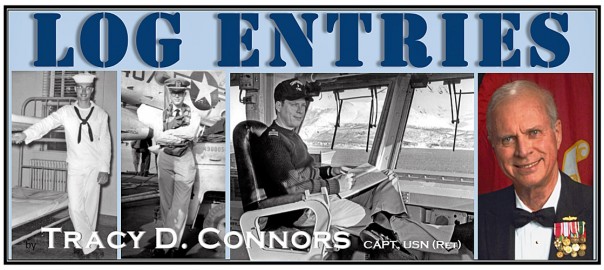Signal flags are still important aboard Navy ships, helping those within visual range to share important information such as course and speed…but this flag combination brought questions, and then gales of laughter on the bridge of this carrier.
On the bridge of the Rosy one afternoon we had a mix up of signals between us and and the bridge of an oiler while we were attempting to come alongside.
A new “Navigator” had reported aboard. As was the case for almost all senior officers assigned to the aircraft carrier, the new department head was an aviator. It was clear that his “sea duty” experience was very limited, and that may have been an understatement.
In the Sixties carrier CO’s were Aviators who were just coming off a year as CO’s of oilers or ammunition ships to give them “deep draft” experience. On ROOSEVELT, all OOD’s, inport and underway, were surface warfare officers, although that designation had not yet been established. JO aviators/pilots would stand a few bridge watches as JOOW’s to “observe,” then be given their underway qualification letters, but never allowed to actually assume the watch as the OOD. Actual OOD’s were surface officers (“black shoes”) from the Gunnery Department, or in my case, from Operations/CICWO.
I had volunteered to stand double watches to get qualified on the bridge as well as in CIC. JO’s wanting to earn qualification as OOD u/w went through a rigorous training and shipwide familiarization program that took many months to complete. Many went through the training, but were never given their “letters.”
When we were anchored (we could never moor in a foreign port), the black shoes stood the inport Quarterdeck watches, and the pilot JO’s were assigned boat officer duties on the utility boats that shuttled back and forth to fleet landing.
While making an underway replenishment approach on USS F. D. Roosevelt (CVA 42), we always had our best Quartermaster Helmsman at the wheel. Approaching at 25 knots (to the 12 knots of the replenishment ship), we went to All Back Full when that ship’s stern was abreast our bow (as notified by the bow lookout via the JL circuit).
At about 15-16 knots, we rang up turns for 12 knots to settle down alongside abeam at 180 feet. The Quartermaster was then often given orders that might require him to steer in 1/4 degree increments to maintain proper separation. It was tricky because the bow waves of the two “large combatants” could raise the sea level between the ships by 3-4 feet and push us away. The helmsman had to steer just slightly to the right of Romeo Corpen to maintain proper separation.
As the OOD u/w and Asst. Navigator (their Division Officer) I always had the greatest respect for their ability to anticipate the rudder angles needed to maintain our position. Rather than give them precise rudder angles or even headings, my typical orders were to “Steer to maintain course xxx.” They could do that better than any of us.
On this afternoon, as we were making our high speed approach on the oiler, the Captain suddenly announced that he had the conn (was maneuvering the ship himself), then announced that Commander “Neversail” had the conn. I was amazed. I assumed that he wanted the new Navigator to get some experience, but to actually let him maneuver the ship (with the Captain making “recommendations” while standing right beside him), was risky as we were barreling down on the unsuspecting oiler.
“Things” didn’t go well, as they say. He was late in going to All Back Full to slow our speed, and we slid past the oiler by a ship length. Then, to speed things up, he chopped the speed too much and we fell behind. I could see the oiler’s bridge watch team staring at us and laughing. We had become the comic interlude for their otherwise boring day.
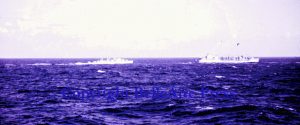
After a second and third attempt to get alongside, our signal bridge called me as the OOD… “Sir, the oiler is flying some strange flags.”
“What are they?” I asked as I stepped out onto the starboard wing of the bridge so I could see them better.
Together the Signals Petty Officer and I tried to make sense out of the following “signals”–a church pennant (white with a horizontal red cross), then the Interrogative pennant, followed in descending order by flags that were never to be found in the “official” USN flag bag, including: #, *, @, and *, plus a couple that are not on a typewriter keyboard, including a dervish or tornado symbol.
We were baffled.
Through the binoculars, I could see the oiler’s CO and bridge watch team laughing their butts off at us staring at their strange flag signals. They knew we were trying to decide what they meant.
Finally, after at least twenty minutes of erratic maneuvering, some of which had our own Chief Engineer calling up to the bridge on the 21 MC wondering “what the hell was going on up there,” the Fru Dee Roo was alongside the oiler.
[Of course, the “black shoe” watch team was trying not to smirk at the comical scene. But we did feel SO superior knowing that we would never have made such a spectacle of lubber-like “seamanship.”]
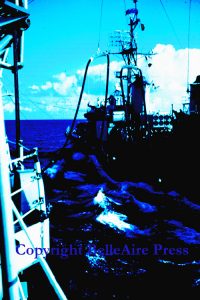
Finally, most of our watch team and the CO were out on the starboard wing staring at the flags.
Nobody had a clue.
Finally, the oiler’s refueling hoses were in place and we were steaming on parallel courses and the same speed. In addition to the refueling lines, there was a hookup to a sound powered telephone (we were in EMCON ALPHA, no electro-magnetic radiation from the ship at all).
I went over to the barrel switch on the bridge that could connect to any sound powered circuit anywhere on the ship and dialed up the circuit connecting the two ships. I told them I was the OOD and that I wanted to speak to their OOD.
When I got him on the line, I inquired, trying to not sound too ignorant, about the “unusual” flag combination.
After he stopped laughing, he explained that his CO had been confused by our temporary mix-up of directions as we started the underway approach.
His directions to his signal bridge actually involved two flag signals which when flown together, became a phrase. First, the the Interrogative flag, followed by some flags that represented cartoon symbols for profanity–hashtags, sea spouts, stars. That string became the “What the Hell?” flag signal. However, adding the Church Pennant over that string turned the phrase into “Jesus Christ, What The Hell?” Brilliant. Of course, none of this was in the official signal book, ATP-1, the Allied Tactical Publication.
He knew it would certainly get our attention.
When I with as much animation and tongue-in-cheeking as possible passed that information along to our Captain Gerry Miller (1919-2014), he and the bridge watch team were just about bent double with laughter.
He then went out on the wing of the bridge, caught the eye of the oiler skipper who was on the port wing of his bridge less than 150′ away, and gave him an energetic “thumbs up.”
As he headed back onto the bridge, he said to me over his shoulder, “Have the Signal Bridge make me up one of those.”
I certainly hoped that I was not the OOD u/w when he decided to use that one. I had no idea what I would enter into the log about that “signal.” Sounded like fun, though.
© Copyright 2017-2022 Tracy D. Connors
Other works by Dr. Connors…
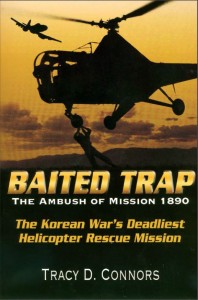
Baited Trap, The Ambush of Mission 1890 is the story of helicopter rescue Mission 1890, one of the most heroic—and costly—air rescues of the Korean War. This harrowing Air Force-Navy mission is explained in compelling detail, creating a detailed personal account of what five incredibly brave and determined Air Force and Navy airmen achieved on June 25, 1952 in the infamous “Iron Triangle.”
The Korean War’s Greatest Love Story
Baited Trap is much more than a heroic war story from the “forgotten war.” It is also the Korean War’s greatest love story, following Wayne and Della Lear, Bobby Holloway, Ron Eaton and Dolly Sharp, and Frankie and Archie Connors as they tried to put their lives and families together even as the Korean War was reaching out to engulf them.
Truckbusters From Dogpatch: the Combat Diary of the 18th Fighter-Bomber Wing in the Korean War, 1950-1953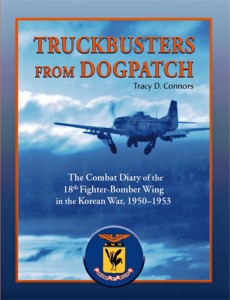
Truckbusters from Dogpatch is the most comprehensive Korean War unit history yet prepared–over 700 pages summarizing squadron histories and first person accounts—and includes over 1,000 never before published photographs and images, highlighted by the 8 ½ x 11-inch format.
Arguably, Truckbusters From Dogpatch is the most authoritative unit history ever prepared on the Korean War. In addition to consulting formerly classified squadron histories filed monthly throughout the conflict, the author was in touch with hundreds of veterans of the 18th—pilots and ground crew—whose personal recollections add vivid detail and emotion to the facts recounted in the official documents.
Recent Log Entries by CAPT Connors…
Carrier Captain’s Night Orders: “Call Me…”
After reading these Night Orders you can better appreciate what training, attention to duty, and vigilance was required by underway watchstanders in those days. What has changed since then that has resulted in the recent tragic collisions between U.S. Navy ships and other vessels?
A “What the Hell” moment for the Bridge of this aircraft carrier
Signal flags are still important aboard Navy ships, helping those within visual range to share important information such as course and speed. Navy ship flag combinations convey special information, but this flag combination brought questions, and then gales of laughter on the bridge of this carrier.
